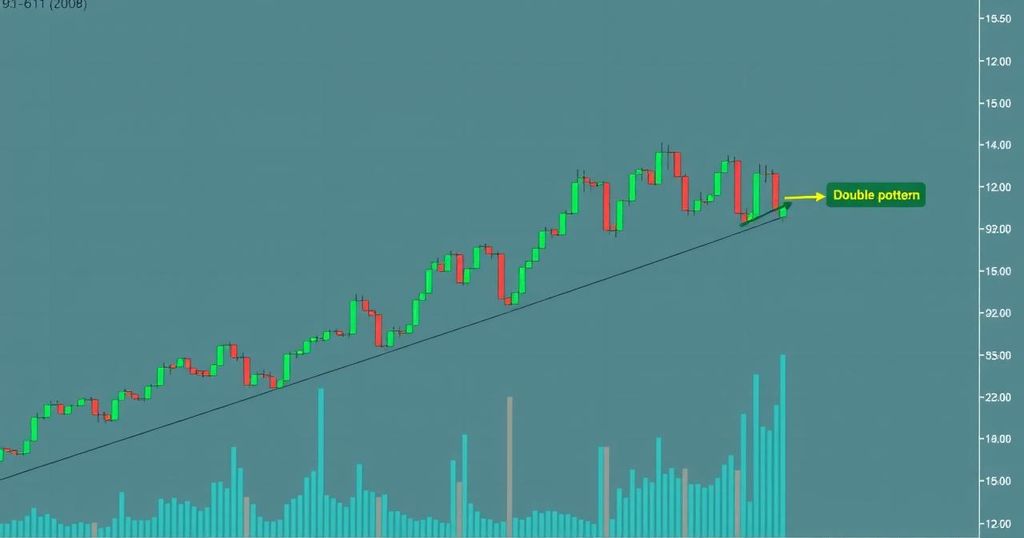Bitcoin Faces Bearish Signals Amid Falling Hash Rate and Macro Risks
Bitcoin trades at approximately $94,296, facing bearish indicators due to rising bond yields and weak on-chain metrics, including a fall in hash rate to 750 TH/s. ETF outflows of $572 million have further contributed to market concerns. A bearish head-and-shoulders pattern suggests possible declines below $90,952, although a weekly bullish pennant pattern may counteract this if Bitcoin remains above $90,000.
Bitcoin (BTC) is currently trading at approximately $94,296 as it encounters bearish market signals driven by macroeconomic factors and concerning on-chain metrics. The U.S. Bureau of Labor Statistics revealed an addition of 256,000 jobs in December, accompanied by a decrease in unemployment to 4.1%. This positive economic news prompted significant sell-offs across U.S. equity markets, impacting risk assets such as Bitcoin.
In addition, bond yields surged, with the 30-year yield reaching 5.0%, while the yields for 10-year and 5-year notes rose to 4.76% and 4.57%, respectively. Such increased yields have bolstered expectations of a hawkish Federal Reserve, further influencing market sentiment against cryptocurrencies.
Recent on-chain data reveals a concerning decline in Bitcoin’s hash rate, a crucial indication of the network’s strength, which fell to 750 TH/s as of January 11. This drop is significantly below the 30-day high of 911.88 TH/s and the average of 793 TH/s. Additional metrics indicate that active Bitcoin addresses decreased from 900,000 to 775,000, showcasing decreased network activity. Furthermore, Bitcoin ETFs registered cumulative outflows of $572 million over a two-day span, indicating that many investors are exiting their positions due to prevailing market uncertainties.
Technically, Bitcoin faces potential bearish risks; the formation of a head-and-shoulders pattern on the daily chart—a recognized bearish indicator—highlights these risks, especially with the neckline positioned around $90,952. Additionally, the Relative Strength Index (RSI) and the MACD are both suggesting bearish divergence. Should Bitcoin breach the neckline, it could lead to declines reaching its 200-day moving average at $78,285, followed by the $73,985 level, which has not been experienced since March 2024.
Nevertheless, amid these short-term bearish signals, Bitcoin’s weekly chart remains optimistic, showing a valid bullish pennant pattern as long as BTC stays above $90,000. If this pattern continues to hold, there is potential for recovery and sustained bullish momentum despite the current headwinds.
In conclusion, the current analysis underscores critical points: Bitcoin’s hash rate has fallen to 750 TH/s, presenting network security concerns; there have been notable outflows of $572 million from Bitcoin ETFs; a break below the $90,952 mark could lead to further declines; however, the bullish pennant pattern on the weekly chart may signal a possible recovery if Bitcoin maintains its position above the $90,000 threshold. Investors should remain vigilant and closely monitor forthcoming decisions from the Federal Reserve as well as ongoing macroeconomic developments.
The cryptocurrency market is heavily influenced by macroeconomic events and on-chain data. Notably, reports from the U.S. Bureau of Labor Statistics provide crucial insights into economic conditions that affect investment decisions. As Bitcoin operates in a highly volatile environment, factors such as employment rates, bond yields, and Federal Reserve policies play significant roles in shaping market dynamics. On-chain metrics, including hash rate and active addresses, serve as vital indicators of Bitcoin’s network health and investor engagement, helping to forecast potential price movements.
In summary, Bitcoin is under pressure from declining hash rates and bearish technical indicators, prompting concern among investors. The recent macroeconomic data from the U.S., along with substantial ETF outflows, suggests a cautious market outlook. However, the potential for recovery remains intact, contingent on Bitcoin’s ability to hold above critical support levels. Investors are encouraged to stay informed about both economic developments and Federal Reserve actions that could influence future market behavior.
Original Source: www.fxleaders.com








Post Comment